There are plenty of breastfeeding positions to choose from, but you need to find one that’s right for you and your baby. This handy guide should help.
-
Tracking cycle
-
Getting pregnant
-
Pregnancy
-
Help Center
-
Flo for Partners
-
Anonymous Mode
-
Flo app reviews
-
Flo Premium New
-
Secret Chats New
-
Symptom Checker New
-
Your cycle
-
Health 360°
-
Getting pregnant
-
Pregnancy
-
Being a mom
-
LGBTQ+
-
Quizzes
-
Ovulation calculator
-
hCG calculator
-
Pregnancy test calculator
-
Menstrual cycle calculator
-
Period calculator
-
Implantation calculator
-
Pregnancy weeks to months calculator
-
Pregnancy due date calculator
-
IVF and FET due date calculator
-
Due date calculator by ultrasound
-
Medical Affairs
-
Science & Research
-
Pass It On Project New
-
Privacy Portal
-
Press Center
-
Flo Accuracy
-
Careers
-
Contact Us
The best breastfeeding positions for moms and babies
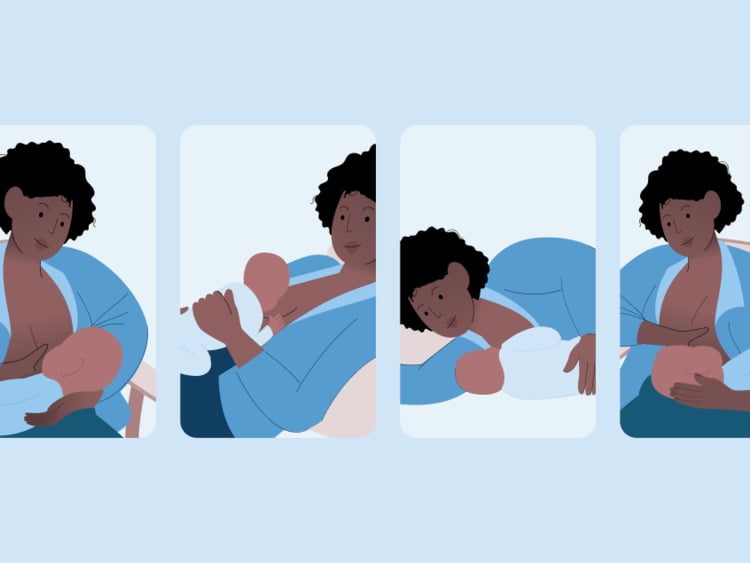

Every piece of content at Flo Health adheres to the highest editorial standards for language, style, and medical accuracy. To learn what we do to deliver the best health and lifestyle insights to you, check out our content review principles.
Breastfeeding can feel like a lot to take on at the start as you adapt to using your body in a whole new way. And if you can master it, that’s great! There are many known health benefits for infants who are breastfed, including protection against some childhood illnesses, a strong source of energy and nutrients, and a reinforced bond between mother and baby.
However, that’s not to say it’s always easy. Research from the US Centers for Disease Control and Prevention shows that while over 84% of babies start breastfeeding, only 58.3% are still nursed from the breast at the age of 6 months. This may be because some people may find breastfeeding difficult and decide to stop, which is totally natural and your decision to make.
If you’ve recently started breastfeeding, you might feel as though you’re receiving lots of information from all angles — things like the best breastfeeding positions, how to get a good latch, and all the things you should and shouldn’t do while nursing. It can be hard to filter through it all and to know what’s right for you and your baby.
But as always, when it comes to your body, it’s important to make sure you’re breastfeeding in a way that works for you personally. With lots of different options, if you’re hoping to find the best breastfeeding position for you and your little one, it might be a good idea to try out some of the suggestions listed below, as recommended by Dr. Sara Ritchie, assistant professor of pediatrics at the Medical University of South Carolina. Give them a try and see what works for you.
Best breastfeeding positions: Football position

Dr. Ritchie says: “In my opinion, this is the most versatile position. It works well in bed or in an armchair; you can fold a pillow in half and stuff it between the arm of your chair and against your flank [the area between your lower ribs and your hips] for extra comfort.”
How to do this breastfeeding position:
- To start, you want to be sure that you have created a surface for the baby to rest on under the armpit and against the flank of the side you want to nurse from.
- A nursing pillow can be shifted so that the C is circling your side (so a portion wraps behind your back and a portion wraps around your front).
- Position the baby on top of the pillow with its belly angled toward your side.
- Use that same side arm to rest behind the baby and the same side hand to help support your baby’s head/neck.
- The opposite hand should support the breast to guide it toward the mouth for a comfortable and well-supported latch.
Take a quiz
Find out what you can do with our Health Assistant
Best breastfeeding positions: Cross-cradle position
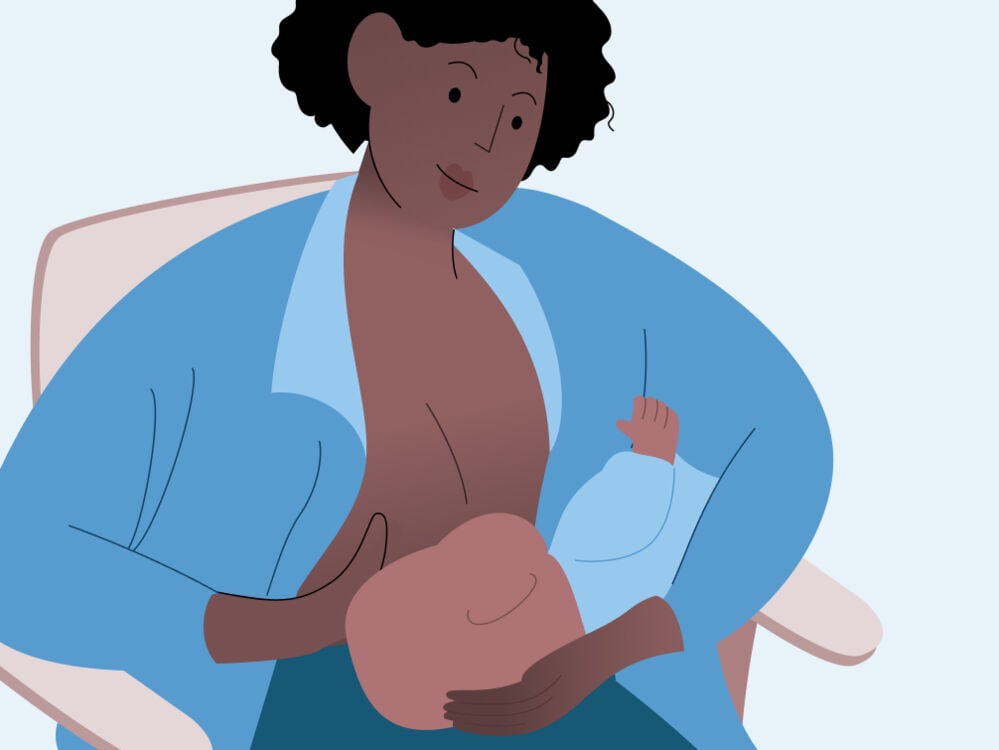
Dr. Ritchie says: “A close second, this is a very popular and natural way to nurse. It also works well in bed or in an armchair. The cradle position [more on that below] is this same setup except the mother’s arms are reversed, but I prefer cross cradle because the baby’s head is better supported.”
How to do this breastfeeding position:
- To start, place a firmer pillow (or two) across your lap.
- Position your baby with their belly angled toward your body and mouth close to your nipple.
- The hand on the same side of the nursing breast should cup your breast to help support and angle it toward the baby’s mouth.
- The opposite arm should rest over and behind the baby.
- The opposite hand should support the baby’s head and neck to help angle its head for a good latch.
Best breastfeeding positions: Laid back breastfeeding
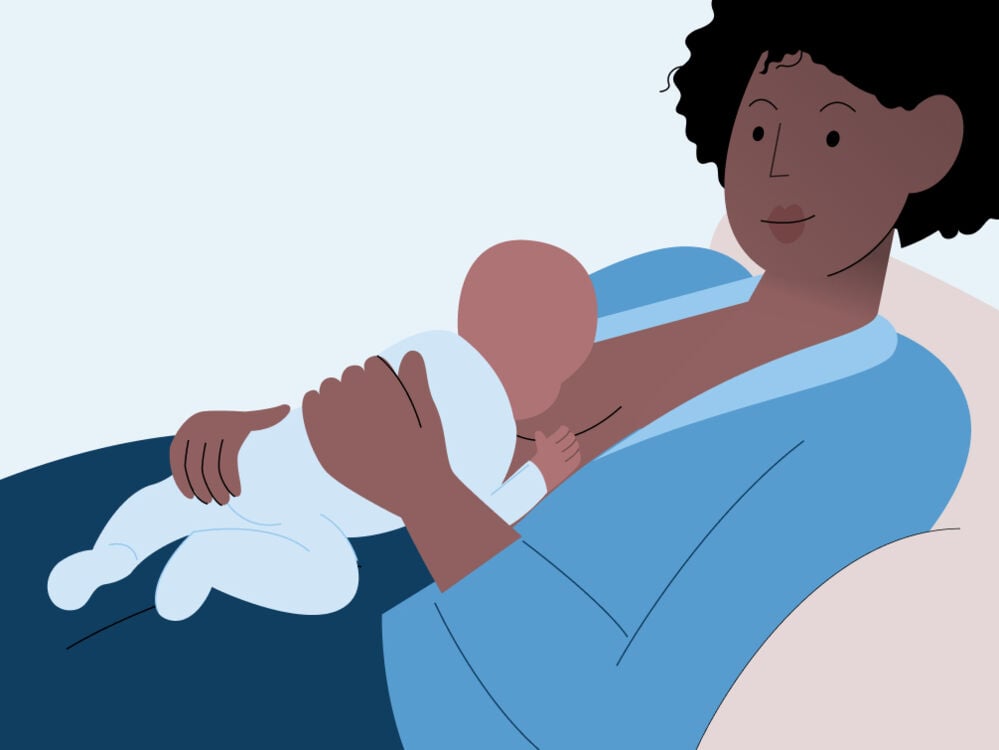
Dr. Ritchie says: “This position is biologically nurturing, making it great for newborns (especially that just-born skin-to-skin first nursing session). But it can work well at any age. With this position, you want to be very careful not to fall asleep while nursing.”
How to do this breastfeeding position:
- You should start in a reclined position, for example leaning back against pillows in bed or in a recliner chair. The reclined position will keep the baby in place against your body.
- Position the baby with its head almost resting on the breast. The baby’s belly should be touching your belly.
- You can use one hand to support the baby on your belly and the other to guide your breast toward the baby’s mouth.
- Gently rubbing your nipple against the baby’s cheek or upper lip will help them turn toward the nipple for a good latch.
Best breastfeeding positions: Side-lying position
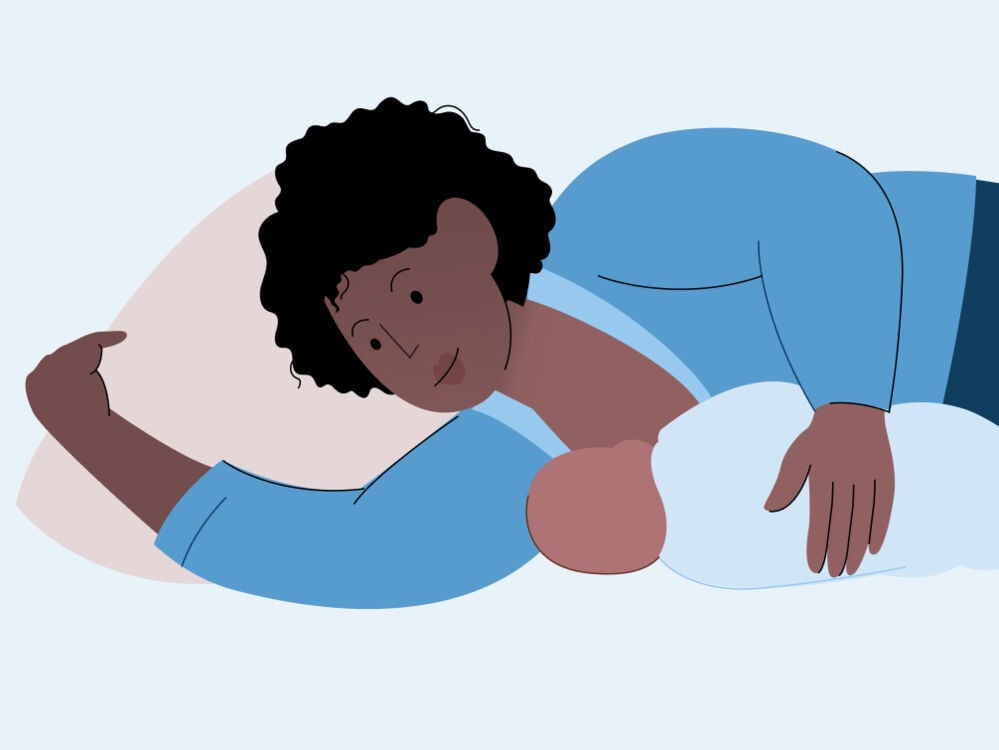
Dr. Ritchie says: “Side-lying breastfeeding works better for older babies, but it can be used at any age. A firmer mattress is preferred with this position, and of course, you want to be very careful not to fall asleep while nursing.”
How to do this breastfeeding position:
- Both you and the baby start by lying on your sides, facing each other.
- Position the baby’s head close to the breast (making sure it’s also close to the mattress).
- Your underarm can go under the baby’s head and support their back.
- Your upper arm can help guide and support the breast for a good latch.
Best breastfeeding positions: Cradle position
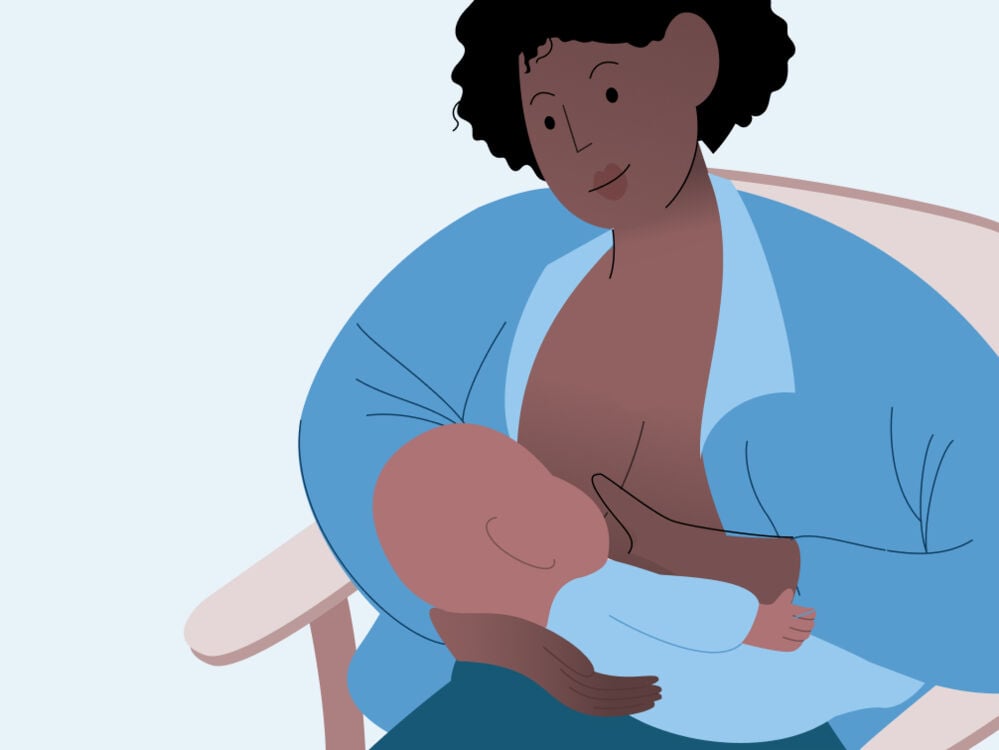
Dr. Ritchie says: “I don’t love this position as much because it’s harder to support the breast, but all nursing relationships are different, and it’s still worth exploring.”
How to do this breastfeeding position:
This is the same as the cross-cradle position, however, you use opposite hand positioning. So, it works as follows:
- Place a firmer pillow (or two) across your lap.
- Position your baby with their belly angled toward your body and mouth close to your nipple.
- The hand on the opposite side of the nursing breast should cup the breast underneath to help support and angle it toward the baby’s mouth.
- The other arm should rest under the baby.
- The hand on the same side as the nursing breast should support the baby’s head and neck to help angle its head for a good latch.
Best breastfeeding positions: Sling nursing

Dr. Ritchie says: “This position is better when you feel confident with nursing skills and carrying skills separately. But once those skills are mastered, it’s a good one.”
How to do this breastfeeding position:
- The baby should be carried facing you in the sling.
- You gently reveal your breast and allow the baby to latch while the sling supports their body and head.
- You can use your hand to support the breast until the latch feels strong and comfortable.
Best breastfeeding position for twins: Football position for twins

Dr. Ritchie says: “Some twins do well nursing at the same time, but sometimes nursing separately might be better (for example, if one twin is having more trouble feeding than the other). If feeding in tandem, the football position is great!”
How to do this breastfeeding position:
This is exactly the same as the football position, just using both breasts at the same time. To remind you, it works as follows:
- To start, you want to be sure that you have created a surface for each baby to rest on under your armpits and against the flanks of each side.
- Position each baby with their belly angled toward each of your sides.
- Use your arms to rest behind each baby and your hands to help support your babies’ heads/necks.
Which breastfeeding position is best for someone who’s recently had a C-section?
If you’ve recently given birth via cesarean section, you might need to take this into consideration when breastfeeding. “Sometimes discomfort or pain with the incision can interfere with finding a comfortable nursing position,” explains Dr. Ritchie.
Her suggestion for the best post-C-section breastfeeding position to try? The football position, as there’s “no pressure being put on the incision site,” she says. “Be sure to use plenty of pillows or a good nursing pillow under your baby so they are well supported in this position. The outside hand should be supporting the baby’s head/neck, and the inside arm should be supporting the opposite breast.”
“Side-lying is also a comfortable way to nurse without aggravating the incision,” Dr. Ritchie adds.
How do you know when you should switch breastfeeding positions?
There are many reasons why you might consider exploring alternative breastfeeding positions, and it can sometimes be hard to know when a change is the right thing. Dr. Ritchie advises keeping an eye out for the following signs, which could be an indication that you should try switching up how you feed:
- Your breasts don’t feel empty after a feed.
- Your breasts feel engorged (swollen with fluid) and not relieved after a feed or feel like one side of the breast is not relieved after feeding (if it still feels hard/engorged).
- You experience nipple pain even with a proper latch.
- Your baby is having a hard time latching on.
Are there any breastfeeding positions you should avoid?
As we’ve explained, breastfeeding is a hugely personal experience, and you should listen to your body and your baby when deciding what’s best. But there are a couple of positions Dr. Ritchie would avoid for the sake of you and your little one.
“Avoid leaning over as this can strain the back/neck/shoulders. It can also contribute to sore nipples,” she explains. “Also, stay away from positions that don’t allow you to support your baby’s neck/head with one hand while the other supports the breast. We often forget how important it is to support the breast.”
Best breastfeeding positions: The takeaway
Now that you’ve heard Dr. Ritchie’s recommended breastfeeding positions and have seen how they work, hopefully, you feel confident to give some of them a try. Beyond that, the pediatrics expert has some other fail-safe tips to help you master breastfeeding. “In general, be sure you are comfortable and your baby is close with its head aligned so they don’t have to turn to reach the breast,” says Dr. Ritchie.
“In the hospital nursery, we say, ‘stomach to stomach’ and ‘skin to skin,’ so try to remember those key things,” she says. “Be sure the breast is supported. Be sure the latch is deep.”


Hey, I'm Anique
I started using Flo app to track my period and ovulation because we wanted to have a baby.


The Flo app helped me learn about my body and spot ovulation signs during our conception journey.


I vividly
remember the day
that we switched
Flo into
Pregnancy Mode — it was
such a special
moment.
Real stories, real results
Learn how the Flo app became an amazing cheerleader for us on our conception journey.
References
Behe, Caroline. “Positioning.” La Leche League International, www.llli.org/breastfeeding-info/positioning/. Accessed 7 July 2022.
“Breastfeeding.” Start4Life, www.nhs.uk/start4life/baby/feeding-your-baby/breastfeeding/. Accessed 7 July 2022.
“Breastfeeding.” World Health Organization, www.who.int/health-topics/breastfeeding. Accessed 7 July 2022.
“Breastfeeding Report Card.” Centers for Disease Control and Prevention, 24 Nov. 2021, www.cdc.gov/breastfeeding/data/reportcard.htm.
Weaver, Jennifer M., et al. “Breastfeeding Duration Predicts Greater Maternal Sensitivity over the Next Decade.”
Developmental Psychology, vol. 54, no. 2, Feb. 2018, pp. 220–27.




